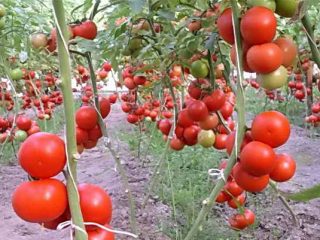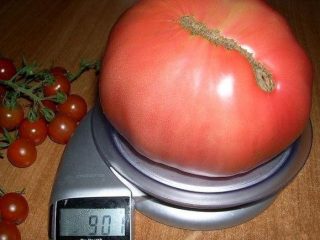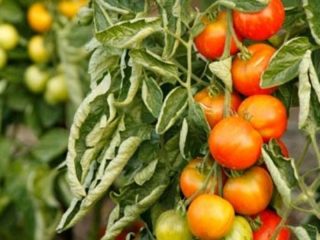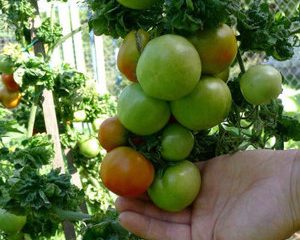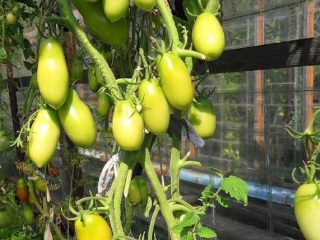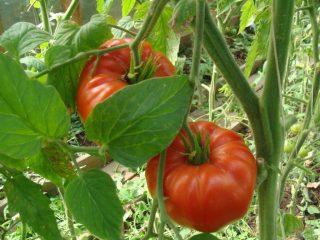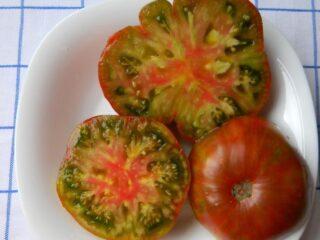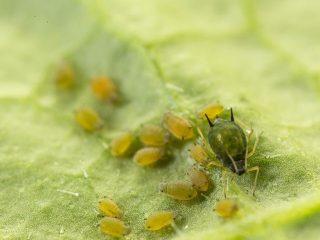Content
Tomato Thick cheeks is a mid-season variety with excellent taste, productivity and disease resistance. Its ease of care made it suitable not only for growing in garden plots, but also for industrially growing vegetables. Thick cheeks are a variety that belongs to beef tomatoes. This category of large-fruited tomatoes is also called “meat” for the special texture of the pulp.
Breeding history
The Thick Cheeks tomato was bred by a group of breeders from the Russian agricultural company Aelita. Selection work was carried out by O. A. Karmanova, M. N. Gulkin, S. V. Matyunina, V. G. Kachainik.
In 2015, the new variety was approved for use. The quality characteristics of the tomato were highly rated. It immediately appeared on the list of breeding achievements of the Russian Federation and is still considered one of the best selections of the originator.
Description and characteristics of tomato Thick cheeks
Plants of this variety are indeterminate. The bushes develop powerful and spreading.They grow continuously. In the climatic latitudes of the Russian Federation, their height reaches a maximum of 2 m. Tomato leaves are long and light green in color. The flowers are yellow, inconspicuous, the inflorescence is intermediate.
The first bunch of fruits is usually laid at a height of 10 leaves. The brush consists of 4-6 ovaries.

Average fruit weight Thick cheeks – 300 g
The tomatoes are red, round-flat in shape, with a medium-ribbed surface. The pulp is fleshy, juicy, and has high taste. The skin is dense, the fruits do not deform during long-term transportation, are stored for a long time, and retain their presentation. The tomato is a varietal one.
You can collect seeds from fruits and get a good harvest next season, saving money on the purchase of planting material.
Ripening time
Tomato Thick cheeks belongs to the group of mid-season varieties. Ripening period is from 115 to 120 days. Harvesting begins in July and ends in September. Timing may be adjusted depending on climatic conditions in the region and the date of planting of seedlings.
Tomato yield Thick cheeks
If agricultural practices are followed, each tomato bush can produce about 6 kg of tomatoes. From 1 sq. m you can collect up to 10 kg. Thick cheeks have large fleshy fruits weighing from 200 g to 400 g. From 4 to 6 pieces are usually tied on one brush. If you remove half of them, you can increase the weight of the fruit to 600-800 g.
Resistance to adverse factors
The Thick Cheeks variety is resistant to most diseases, both bacterial (verticillium, fusarium) and viral (tobacco mosaic virus).Tomato is noted to be stress-resistant to sudden drops in temperature and short-term drought. The crop tolerates short-term extreme heat, and even recovers when damaged by return frosts.
Where is it grown?
Thick cheeks are a tomato that is suitable for growing outdoors in the southern regions. In greenhouse conditions it is permissible to grow in the middle zone.
Methods of application
Tomato fruits Thick cheeks have a pleasant rich sweet taste. The pulp is juicy and sugary, so they are most often consumed fresh, in vegetable salads. They are also suitable for making juice, ketchup, adjika, and tomato paste. The variety is also well suited for preservation.
Advantages and disadvantages
Thick cheeks is a varietal tomato, so you can collect the seeds yourself and sow them for the next season. At the same time, all selection features will be preserved. Tomatoes are tall and productive, which is extremely important for small garden plots and greenhouses, because you can reap a bountiful harvest from a small area.

Thick cheek tomatoes have high commercial characteristics, so the variety is suitable for industrial cultivation
Pros:
- pleasant sweet taste;
- large fruit size;
- thick skin;
- meaty and juicy texture;
- increased productivity;
- ease of care;
- resistance to most diseases.
Minuses:
- bushes require timely pinching and removal of leaves;
- large fruits without a garter can damage the branches.
Features of agricultural technology
You need to sow tomato seeds Thick cheeks in greenhouses or seedlings in the second half of March - the first ten days of April.To form a strong root system, you need to pick up the seedlings when the first true leaves appear on them.
Seedlings need to be hardened off. Three weeks before planting in open ground, you need to take it outside or into a cool loggia for a short time.
Seedlings are planted in the beds in the second half of May - in the beginning of June. Thick cheeks tomato seedlings are placed at a distance of 40 cm between holes, 50 cm between rows. After planting, the plants must be tied up.
To prevent the plant from wasting energy forcing side shoots, it is necessary to remove them. Then the nutritional elements will be directed to the ripening of tomatoes, and not to the forcing of green mass.

To increase productivity, it is recommended to trim foliage and shoots.
Care Tips
In the first two weeks after planting seedlings in open ground, do not water abundantly so that the root system develops deeper. If you plan to carry out drip irrigation, you can not change the watering regime after planting and throughout the entire growing season of the plant. Tomatoes need to be watered approximately three times a week. You need to focus on the amount of precipitation that falls in the planting region.
In order for tomato bushes to produce maximum yield, it is important to provide the plant with the necessary nutrition. You can use both organic and mineral fertilizers. In the development phase of stems and leaves, it is necessary to provide the plant with three elements: nitrogen, phosphorus and potassium. And in the phase of flowering and the formation of the first fruits, the need for potassium supplements increases. Also, by this time the plants are already using up the available supply of phosphorus.During this period of time, you need to feed the plant, which contains potassium nitrate and potassium monophosphate.
It would be a good idea to shade the plants during periods of maximum temperatures so that the tomatoes do not get burned.
Treatment against diseases and pests
To prevent the development of diseases, it is recommended to do preventive treatments. Two weeks after planting Thick Cheeks tomatoes, you need to treat them with copper-containing preparations, such as Bordeaux mixture, Azofoska or Hom. These products also have insecticidal properties. Repeated treatment should be carried out after a week.
The second mandatory step is treatment based on Trichoderma and Bacillus subtilis. These antagonist bacteria fight against pathogenic pathogens and suppress them. Spraying should be repeated every 10 days. If insects such as aphids, thrips, whiteflies, leafhoppers, cutworms and caterpillars are found on plants, it is necessary to treat them with appropriate insecticides. It is better to give preference to biological drugs, for example, Actofit or Fitoverm.
Conclusion
Tomato Thick cheeks is a variety that both beginners and experienced gardeners should pay attention to. Unpretentiousness, ease of care, resistance to weather changes and diseases are good reasons to try growing this variety on your site in the coming season.
Reviews from gardeners about the tomato variety Thick Cheeks
